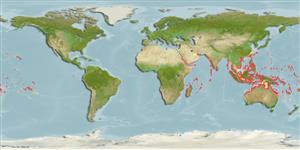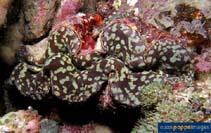Tridacna maxima (Röding, 1798)
Elongate giant clam| Native range | All suitable habitat | Point map | Year 2050 |

|
| This map was computer-generated and has not yet been reviewed. |
| Tridacna maxima AquaMaps Data sources: GBIF OBIS |
رده بندی / Names اسامي عام | مترادف | CoL | ITIS | WoRMS
Bivalvia | Cardiida | Cardiidae
Environment: milieu / climate zone / تغييرات عمق / distribution range بوم شناسي
وابسته به آب سنگ; غير مهاجر (مرجع 348); لب شور; تغييرات عمق 0 - 35 m (مرجع 348). Tropical; 23°C - 30°C (مرجع 102835); 28°N - 37°S, 31°E - 128°W
Distribution كشورها | مناطق سازمان خوار و بار جهاني (FAO) | Ecosystems | ظهور | معرفي
Indo-Pacific: Egypt to Pitcairn Islands and Ogasawara, Japan to Lord Howe Island.
Length at first maturity / Size / Weight / سن
بلوغ: Lm ?, range 6 - 13 cm Max length : 41.7 cm SHL جنس نر / بدون خواص جنسي; (مرجع 117184); common length : 25.0 cm SHL جنس نر / بدون خواص جنسي; (مرجع 348)
توصيف مختصر ريخت شناسي
Life cycle and mating behavior بلوغ | تولید مثل | تخم ریزی | Eggs | Fecundity | Larvae
مآخذ اصلی
مراجع | هماهنگ كننده | همكاران
SAUP Database 2006 SAUP Database. www.seaaroundus.org. (مرجع 356)
وضعيت در فهرست قرمز IUCN
(مرجع 130435: Version 2025-1)
وضعيت از نظر سايتس (مرجع 108899)
CMS (مرجع 116361)
خطر برای انسان ها
استفاده انسانی
ماهي گيري – شيلات: تجاري
FAO - آبزي پروري: production; | FishSource | Sea Around Us
ابزارها
اطلاعات بيشتر
منابع اينترنتي
BHL | BOLD Systems | CISTI | DiscoverLife | FAO(; publication : search) | Fishipedia | GenBank (ژنوم, نوکلئوتيد) | GloBI | Gomexsi | Google Books | Google Scholar | Google | PubMed | Tree of Life | Wikipedia (برو, جستجو) | Zoological Record



